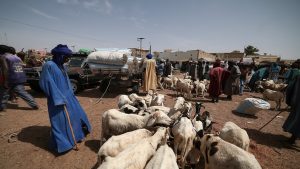Muslims from across the world gathering in Mecca in Saudi Arabia for the annual hajj pilgrimage will take part in the following rituals:
First phase
– Ihram: For the Muslim faithful, hajj begins with the donning of a special outfit, which for men is a two-piece white seamless garment. Women wear loose dress, generally white, with only the face and hands exposed. During this period, pilgrims must abstain from sex and quarrelling, not use perfume and not cut their hair or nails.
– Tawaf: Once in Mecca, pilgrims perform Tawaf, or circumambulation, seven times counter-clockwise, around the Kaaba, a black masonry cube in the centre of the Grand Mosque.
– Sa’i: Pilgrims then walk seven times between two stone spots at the mosque, emulating a search for water by Ibrahim’s wife Hajar in a ritual known as Sa’i. According to religious texts, Hajar was seeking water for her infant son Ishmael in the hot desert when she found water in the Zamzam well on her seventh try.
These rituals are considered the umra, or lesser pilgrimage, and come ahead of the hajj’s main rites when pilgrims head to Mina, around five kilometres (three miles) east of the Grand Mosque.
Mount Arafat
The next day, pilgrims gather on the hill known as Jabal al-Rahma (Mount of Mercy) and the surrounding Mount Arafat plain, 10 kilometres southeast of Mina, where they remain until evening for prayer and to read the Koran.
The prophet Mohammed delivered his final sermon from Mount Arafat to Muslims who had accompanied him on his final hajj, according to Islam.
Stoning the ‘devil’
After sunset, pilgrims leave for Muzdalifah, half-way between Arafat and Mina, where they stay at least until midnight.
They gather pebbles to perform the symbolic “stoning of the devil” on the eve of the Eid al-Adha feast, which marks the end of hajj.
At the start of Eid al-Adha, pilgrims return to Mina for the first of three daily stoning rites.
Traditionally, seven pebbles are thrown at a post representing the devil, emulating the actions of Abraham.
Since 2004, the post has been replaced by walls to accommodate the rising numbers of pilgrims. In 2015, a stampede at the site left 2,300 people dead.
After the first stoning, sheep are slaughtered and the meat distributed to needy Muslims, symbolising Abraham’s willingness to sacrifice his son Ishmael on the order of God, who provided a lamb in the boy’s place at the last moment.
Men then shave their heads or trim their hair while women cut a fingertip-length off their locks. After that they can end their ihram and change back into normal clothing.
Pilgrims return to the Grand Mosque in Mecca, circumambulating seven times around the Kaaba, and again performing Sa’i.
They then return to Mina to continue the stoning ritual for two or three more days.
Finally, they return to the Grand Mosque, circumambulating the Kaaba seven times.






